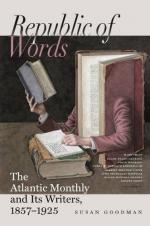Does he seek Nature? No. Nature goes with him; and whether he tarry among the Lagoons, where all seems Art or Death, or in the shadow and desolation of the Campagna, in the unclean villages of the Alban Hills, or where the shadows of deserted palaces fall black, broken, and jagged on the red earth of Granada, there she companions him. She shows him, that, after all, Venice is hers, and gives him the white marble enriched with subtilest films of gold, alabaster which the processes of her incessant years have changed to Oriental amber, a city made opalescent by the magic of her sunsets. At Rome she opens vistas away from the sepulchral, out into the wine-colored light of the Campagna, into the peace gladdened by larks and the bleating of lambs; above are pines,—Italian pines,—and across the path falls the still shadow of blooming oleanders. She leads away from squalid towns, and gathers a group of her children,—peasants, costumed in scarlet and gold, under the grape-laden festoons of vines, while the now distant village glows like cliffs of Carrara. How lavish she must have been of her old ideal Spain, the while he dwelt in Granada!—the dance of the gypsies; pomegranates heavy with ripeness hanging among the quivering glossy leaves; olives gleaming with soft ashy whiteness, as the south-wind wanders across their grove up to where the towers of the Alhambra lift golden and pale lilac against the clear sky.
We have dwelt thus lengthily upon this primitive and apparently less important branch of Landscape Art for several reasons: from a conviction that its importance is, and is only apparently less; from the fact that from it have been derived all other classes of landscape; and because a comprehension of its scope and purpose aids more than any other agency in understanding those of the pure and simple Landscape Art.
We have seen Nature ever ready with moods so related to the soul that no ideal worthy of Art might be conceived beyond the range of her sympathies. Even to that event involving all the intensity of human thought and feeling, the last refinement of all spiritual emotion, and a sense of mysteries more sublime than the creation of worlds,—even to the Crucifixion,—Nature gathered herself, as the only possible sign, the only expression for men, then and forever, of the awful significance. The joyfulness of festivals, the pomp of processions, the sublimity of great martyrdoms, the sorrow of defeats, the peace of holiness, the innocence and sweetness of childhood, the hope of manhood, and the retrospection of old age, when represented upon the canvas, find in her forms and colors endless refrain of response.
This truth, that Nature is capable of such cooperation with the human, that she confines herself to no country or continent, and that her expressions are not relative, depending upon the suggestiveness of the human action to which they correspond, but are positive and under the rule of the immutable, enables the artist to evolve the first great class of simple landscape-painting.




